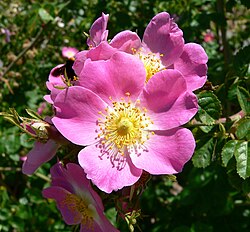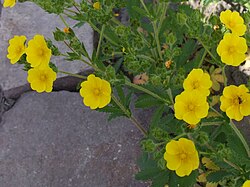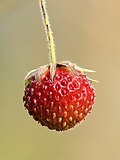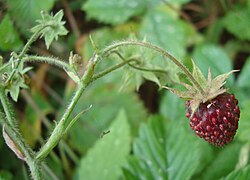Strawberry
A strawberry is a short plant in the wild strawberry genus of the rose family. It is a widely grown hybrid species of the genus Fragaria. The name is used for its very common sweet edible "fruit" and for flavors that taste like it.
| Strawberry Fragaria × ananassa | |
|---|---|

| |
| Strawberry fruit | |
| Scientific classification | |
| Unrecognized taxon (fix): | Fragaria |
| Species: | Template:Taxonomy/FragariaF. × ananassa
|
| Binomial name | |
| Fragaria × ananassa | |
The real fruit of the plant are the tiny "seeds" around the "fruit". The fruit is actually a sweet swelling of the plant's stem around the real fruit, which people call the pips. Although in its name, strawberries are actually not berries.[1]
The plant grown today is a mix of two other species of wild strawberries. It was first grown in the 1750s.
Name
The Latin name of the strawberry used in science is Fragaria × ananassa. Fragaria is the name of the genus of "strawberry-like" plants. The × mark means that it is a hybrid, a mix of two other species. The Latin name ananassa says the hybrid is "pineapple-like". The strawberry is sometimes called the "garden strawberry" so that people don't mix it up with the other wild strawberries of the genus Fragaria.
The name is a bit misleading and is special to English. The other Germanic languages do not have a name like it. No one is really sure where the name came from.[2] The plant is not a kind of straw, and its fruit is not really a berry.
History
People have eaten different kinds of wild strawberries for thousands of years. Today's bigger strawberry was first made around Brest in Brittany (northwest France) in the 1750s. It was made by joining the Virginia strawberry from eastern North America to the European Hautbois and the Chilean strawberry from western South America.[3]
Farming
Most strawberries are grown on farms. Strawberry farmers often have bees in hives. The bees pollinate the strawberries.
Strawberry stems are called runners. They grow above ground. They are a type of stolon.[4]
Fruit
The real fruit of the strawberries are the achenes,[5] which people usually think of as the little seeds around the outside of the larger red "fruit". This kind of fruit, where different ovaries grow into a single larger "fruit", is called an "aggregate fruit".[6][7]
Strawberry Media
Hybridisation and polyploidy in strawberries. Garden strawberries are octoploid (8N), like both parents, the Virginia and Chilean strawberries.
Related pages
References
- ↑ Maxwell, Tom (2020-06-30). "Why Strawberries Aren't Berries, But Bananas & Other Fruits Are". The Daily Meal. Retrieved 2024-08-10.
- ↑ "strawberry, n.", Oxford English Dictionary, Oxford: Oxford University Press, 1919.
- ↑ Welsh, Martin (2006), "Strawberries", Official website, Aylesford: National Vegetable Society.
- ↑ "Stem Modifications". Boundless Biology. Archived from the original on 18 October 2015. Retrieved 22 February 2016.
- ↑ "achenes". Inhs.uiuc.edu. Archived from the original on 2012-08-26. Retrieved 2012-01-19.
- ↑ "Aggretage Fruits". Inhs.uiuc.edu. Archived from the original on 2012-01-23. Retrieved 2012-01-19.
- ↑ "The Strawberry: a multiple fruit". Carnegiemuseums.org. Archived from the original on 2011-12-28. Retrieved 2012-01-19.
- ↑ "Nutrition facts for strawberries, raw, one NLEA serving, 152 g". Nutritiondata.com. Retrieved February 22, 2016.
Other websites
 Data related to Fragaria at Wikispecies
Data related to Fragaria at Wikispecies









